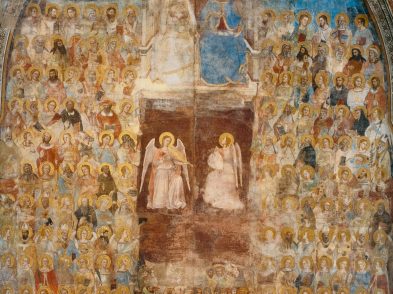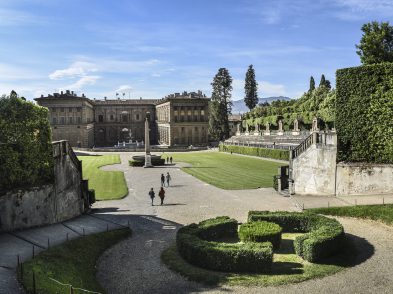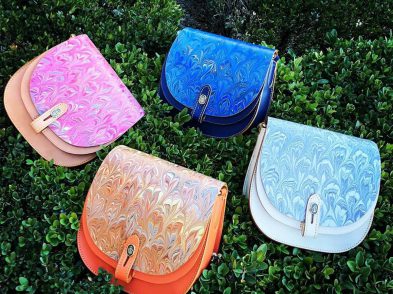Betty Soldi’s mother was sure of one thing: her little girls were not going into the family business of making fireworks. Not just any old family company, the Pirotecnica Soldi had been producing handmade fireworks since 1869, even the display for the Scoppio del Carro, Florence’s famed Easter celebration. No, this was a business for boys.
Fast forward a few decades and here is the grown-up Betty Soldi, making fireworks of her own kind—in ink. Betty Soldi is a calligrapher, designer and wordsmith. A person so brimming with creativity that she defies definition. We sat down one day in one of the two ‘showcases’ she and her partner, Matteo Perduca, have recently opened on via Maggio, called & Company.

Alexandra Lawrence: You moved from your family home in the Valdarno to London at the age of six. Tell me about that transition.
Betty Soldi: It was a big change, going from countryside living to the city. There was my grandmother plucking chickens, having me taste my first vino at age three, plying my sister and me with olive oil and bread for merenda. Then we moved to London. I cried and cried for about three months. Then one day I was on the playground and realized, ‘Yeah, I can play with other kids.’ I had been speaking Italian and then one day I just spoke English. After a few years English dominated. It was a typical English upbringing—except we went to Italian school on Saturdays.
AL: You didn’t miss the bread and olive oil?
BS: At this time in London, if you wanted to eat Italian you had to go into Soho; there were two or three tiny delicatessens. You got your parmigiano there. Of course, whenever we travelled back to Italy we’d bring back sacks of things!
AL: You learned to write in England?
BS: Yes. I remember being taught on a blackboard, I remember the feeling of the handwriting. There were pointy flourishes; it’s very different than from how people are taught here, where it’s all very round.

AL: At a time when there were no cheap flights or email, how did you keep up your connection to Florence?
BS: We spent our summers here. If I was with my father’s family, I was in the countryside eating lots, but if I was with my mother’s family, I was here in via Maggio with my uncle, Sauro Martini, one of the founders of the Palazzo Spinelli restoration school. He is an artisan who has done incredible things, work on La Fenice in Venice and the Kremlin. So, for me there is an amazing legacy of artisan history here.
AL: Tell me about your education.
BS: I came to Florence when I was 18 to study. I had never done art before, but my sister had just done a yearlong restoration course and had had a ball. She had made a group of friends here, and she encouraged me to go and do the same. Matteo [Perduca] was in the group, and we ended up getting together. He would come to pick me up on his Vespa after school, but I was never there! I was out having a cappuccino with my friends or off somewhere. For me, Italy was freedom. In London I went to all-girls convent schools, so this was completely different. The course I did was two years, focused on experimental design, not restoration. It had a modern take and I loved it; I loved living here and knew I had found my calling.
AL: But then you went back to England?
BS: Yes, I went back to England to learn properly because I knew I couldn’t do it here. I was taken by type, typography, words. I was already doing handwriting by then, so I found a course that was strong in that. I had never learned to draw. I went to Ravensbourne, just outside London, for a three-year BA honors. It operates on the Bauhaus philosophy—lots of geometric, linear, Helvetica. I was able to nurture my hand skills. I had an amazing calligraphy teacher: everything was done by hand.
AL: You said that you couldn’t do this type of study here: were there no programs?
BS: No, not because of that. I have an assistant who is doing a design course here. She told me that she had just turned in a project and all her professor said was ‘fa schifo.’ That’s it. You cannot teach like that. This conversation has suddenly brought back all of those differences between approaches—inspiration versus degradation. There’s lots of frustration here.
AL: And after you finished school?
BS: I came back to Florence and tried to work with a photographer, but it was difficult for a young woman without experience to work here, so I went back to London and worked at design companies, building up my experience. I started in fashion, as a fashion forecaster. I was a trend hunter for textiles, colors. I loved it; it was a different way to apply design.
AL: Did your Italian background help?
BS: Absolutely! When people found out I was Italian they just assumed I knew style, it was great. This mix has served me well.

AL: Did you ever work with Italian firms?
BS: No, only English companies. Then I lived in New York for a period and Paris before I went out on my own. I had my own design company in London for 15 years, doing packaging work for luxury retail. I am unique because I mix calligraphy and graphic design whereas most people do one or the other.
AL: What made you decide to return to Florence?
BS: Back to the Oltrarno, you mean! Matteo would come up to London for long weekends; I’d be at work, and he would jump on the Vespa and go explore. He knows London better than most Londoners. But he is a lawyer, so it was not really feasible for him to live there, not that he would have practiced law there, anyway. We were happily carrying on, him here and me in London, but then we did a pro/con list and decided to buy a house together here in the Oltrarno.
AL: How did you come up with the idea for the company, and what is Matteo’s involvement in it?
BS: We wanted to set something up together. Matteo is a true Renaissance man with many varied interests and abilities; he is curious and creative, not your typical lawyer! The idea was to create something that could embrace other people, their skills and projects, while I continued to do what I did in London, but in a more relaxed way. We have friends in London who salvage things and they have an interior design company. We thought we would do something similar—bring a bit of England to Florence, a nod to the Grand Tour almost! Basically, we wanted to be ourselves and see what happened.
AL: When was & Company created? How did you come up with the name?
BS: We opened in February 2012. Years ago, we bought an old Victorian sign that says ‘Company LTD’; it’s now hanging above our door. When we bought it, we weren’t even thinking of a store: we just liked it and thought we would use it somewhere, someday. When we were thinking of names, we wanted to communicate what we are, which isn’t necessarily easy to grasp. We wanted to attract like-minded people and create collaborations. The name ‘& Company’ takes into account that it is not just us, that it is a collaborative effort. Today it’s Alexandra & Company, for example!

AL: The concept seems quite new for Florence.
BS: It is fun to watch people come in, because it is not really a shop, though of course you can buy things here. It is a place to show people what we can do together. It is a think-tank, a cooperative, an inspirational space. We depend on the culture of the person coming in, or we nurture it together. If the person is curious and wants to know more, then we foster that. We are big on personalization; if you see something and you like it, we can do it together.
AL: How do you find like-minded people?
BS: Having two showrooms on via Maggio helps! People wander in, have a look, start to ask questions and we start to talk. That’s how we became part of the team that created the Unusual Florence map and website [http://unusualflorence.blogspot.it/], which features 16 unique spots in Florence, including cafes, boutiques and bookstores.
AL: What has the reaction been to & Company?
BS: We recognize that it might be difficult to define who we are and what we are doing. Our culture is used to things being straightforward, like at IKEA. We are on via Maggio, the antique street par excellence, but we are not necessarily an antiques shop. We don’t even have shelves. Customers are asked to work a bit, to push themselves to get in touch with what it is we are doing. It’s less commercial and more art.

Florence Quickfire
Best bar for an aperitivo?
Wherever you are with friends! One place in Florence that makes you happy or inspires you.
I like the flower market under the portici in piazza della Repubblica on Thursdays; it’s the Florentine version of a flower-filled English Columbia Road or New York’s Union Square market.
Advice for newly arrived students?
Cross the Arno and explore the Oltrarno, especially all around Santo Spirito. It’s a more genuine Florentine experience.
Best day trip in Tuscany?
Lucca and Pietrasanta
Favourite artwork in Florence?
The incredibly old and marvellously magical, inky paper artworks at the Biblioteca Laurenziana.
Favourite Florentine, past or present?
The Leonardo/Michelangelo duality for art, and Dante for words and imagination.
Where would you take a guest who isn’t into art?
The Galileo Galilei museum and a trippaio stand.
Best kids’ activity?
Anything in the fresh air at the Cascine park.
Strangest thing you’ve seen in the city?
Fireworks coming from the Arno river during the antiques biennale at Palazzo Corsini.
Favourite view of Florence?
Walking on the Ponte di Santa Trinita, looking on either side.
Pet peeve about life in Florence.
The missed opportunities—there are no great museum bookshops; for example, an amazing limonaia café at Boboli. In London, the V&A has the best museum shop and wondrous Morris Room café—learn from them!
What would you ask Matteo Renzi over a cup of coffee?
Sugar, one lump or two?! Favourite museum?
I have two: the amazing, stopped-still-in-time La Specola and the underused Marino Marini.
Favourite restaurant, ethnic and Florentine?
Sant’Agostino 23 for Florentine, noodles at Banki Ramen, Dim Sum for oriental.
Best place for a passeggiata
Along the Arno at the Cascine, it almost feels like being in London or Central Park.
Where do you go to relax?
The mercatini del piccolo antiquariato at weekends in piazza Santo Spirito, piazza dei Ciompi etc., you never know what magical things will find you.
Favourite picnic spot.
Wherever you can find a place at the Boboli gardens.
Best place for tea and other English specialties?
Hmmmm, yet to find a good time-for-tea place here!

& Company (via Maggio 47R) is part of the team that created the Unusual Florence map and website http://unusualflorence.blogspot.it, which features 16 unique spots in Florence, including cafés, boutiques and bookstores.
Photo credits @marcobadiani
* Betty Soldi has sprinkled her handwriting all over #theinkissue








